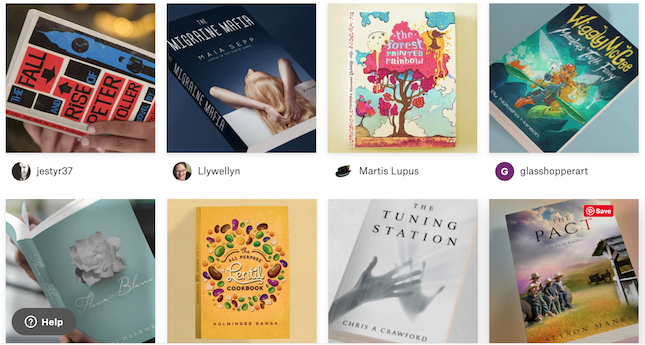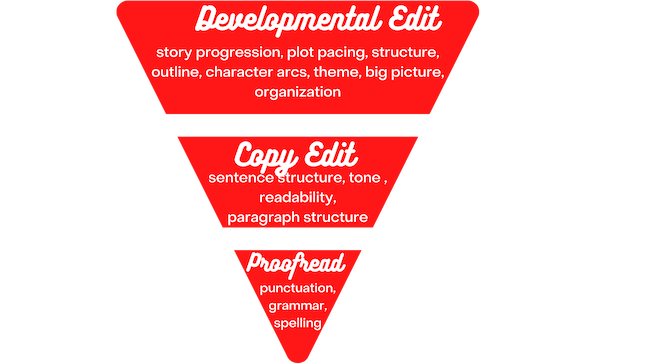
Amazon is the world’s #1 book retailer. Anyone can publish on Amazon, and it’s free. All you need to do is create a publishing account with Kindle Direct Publishing (KDP) and upload your book.
Once you publish, you are in competition with other authors. At the end of 2019, Amazon had published 2 million books. And new books keep coming, at the rate of about one every five minutes. You have a lot of competition.
Is Self-Publishing on Amazon Really Free?
Anyone can self-publish on Amazon, but that doesn’t mean your book will sell. In order to compete among the millions of books, you’ll need to do everything you can to make your book as marketable and competitive as possible.
Reedsy, an online author service, does an annual review of costs:
Most authors spend $2,000–$4,000 to self-publish their books – this includes editing, cover design, formatting, and marketing services.
Let’s break that down.
What to Do to Help Your Book Compete
The three key areas to think about are cover design, editing and marketing. These all go hand in hand.
The strongest marketing you can do for your book is giving it a great cover. The better your book looks, the more likely your potential readers are to click on it. Then, when your readers get to your book’s product page, Amazon’s Look Inside feature allows them to see the first 10% of your book. This can either seal the deal and secure their purchase, or turn them off entirely.
Any spelling or grammar errors glare and can keep a buyer from purchasing your book. Clumsy writing or long sentences can turn away a potential reader. Having a good editor is key to making sure that your content lives up to your cover.
Once you're confident in your book, you need to make sure it sells. Launching your book without a marketing plan will only give you crickets. To help your book compete, you need:
- A genre-specific cover
- A talented editor familiar with your genre
- A marketing plan specific to your audience
This means that you need to budget for each of these items:
- Cover design
- Editing
- Marketing
How much you spend depends on your personal budget. But also consider how much you want your book to succeed. Your investment in making the book marketable pays dividends in royalties.
Cover Design
Choosing a book cover design is one of the most important decisions to make. Your book cover is the first thing a reader sees. Consider hiring a book cover designer as one of your highest priorities before you publish your book.
An experienced cover designer knows how to make each element of your cover pop – the title, your name, and especially the image. A designer familiar with your genre knows the elements readers respond to when they see a book cover.
Readers have expectations and look for clues about the genre on the cover. A cozy mystery and a suspense thriller have very different graphic and visual expectations. You want your readers to know that your book is just the sort of book they like to read.
The cover is your best chance at having your book stand out among the hundreds of thousands of books on Amazon and other retailers. And even when a reader searches by genre, your cover needs to speak to their expectations.
Think of your cover as the brand ambassador for your story. You don't want a fantastic novel to be let down by an underwhelming salesman.
How Much Will a Cover Design Cost?
Book cover designs range in price.
Some designers offer a stock cover to which they add your book details. These usually range from $50–100. If you are on a very tight budget and can find a pre-made cover that works for your book, this is a possible option. Remember that someone else may choose the same design.
Generally, beginner designers charge between $300 and $500. Experienced designers will charge between $500 and $800. Top-tier designers charge between $800 and $1,500.
As you can see, you have a wide range of fees. Choose a designer in the range you can afford to give your book the best stand-out treatment.
How to Find a Cover Designer
If you see a cover you like, check the inside flap to see who is credited. Or, if you have friends who have published, ask them about their cover designer. The beauty of working with an individual designer is you will have input about things like color schemes and images.
Alternatively, go to Reedsy to search through their stable of cover designers. All the designers listed have been vetted for professionalism, and you can read reviews from other authors to make sure you're making the right choice.
New writers often use a crowd-sourced service like 99Designs, CrowdSpring, and DesignCrowd. Make sure to collect a variety of samples before choosing a designer. You submit your request and different designers will respond with ideas. Then, you choose the design you like best.

Editing
From story idea to polished manuscript, editors will help you create the best book possible. An editor gives you an outside, objective view of your text. Editing makes reading your book a joy for readers because they aren’t tripped up by story gaps, clunky writing, or grammar mistakes.
To benefit from the objective overview, put artistic feelings aside and focus on the recommendations. Three types of editing help your manuscript become a story readers love to read.
1. Developmental editing. You will get an in-depth look at every part of your story. This type of editing focuses on your storyline and plot, looking for plot holes, inconsistencies, and better ways to tell your story.
2. Copy editing. An examination of the language you use. The editor looks for the best way to structure your sentences and paragraphs to improve readability. Editing suggestions reveal language that is fluid, clear, and pleasurable to your reader.
3. Proofreading. This final editing step is detail-oriented, looking for consistency as well as grammar, spelling, punctuation, and syntax. After you’ve made all your other editorial changes, this step assures accuracy before you publish.
Each editing process has a particular focus. When you combine all three, you work from the big picture down to the smallest details.
Many editors recommend ProWritingAid to their authors. The editing tool automatically suggests thousands of style improvements that real copy editors would make. This will help you catch any grammar errors, and will also give your writing a readability score, highlight any overused words and visualise your sentence structure and variety. You can find out more about its features here.
This isn't to say that ProWritingAid is a replacement for a real copy editor – far from it. What it can do is allow your real editor to focus on making your writing shine, rather than picking out punctuation mistakes and spelling errors.
Editing Costs
Editing costs are fairly standardized, but you will find some variance in how fees are set. Some editors charge by the word, others by page, and others by the hour, knowing how many pages they can cover in an hour.
1. Developmental editing. A sound average is $.09 per word or $15 per page. Developmental editing rates for your manuscript usually cost between $.07 and $.12 per word. Some developmental editors charge by manuscript page, in the range of $7.50 to $20 per page.
2. Copy editing. This editing stage usually costs between $.02 and $.04 per word. Some copy editors charge by manuscript page, in the range of $2.50 to $5 per page.
3. Proofreading. A basic proofread of your manuscript usually costs between $.01 and $.02 per word. Some proofreaders charge by manuscript page, in the range of $1.50 to $3.50 per page.
Some experienced editors charge by project. This fee is based on your genre and page length. And, some editors combine copy editing and proofreading services.
Reedsy breaks fees down average fees for a 60,000 word manuscript as:
Developmental editing — $1,440 (or about $7 per page) Copy editing — $1,020 (or about $5 per page) Proofreading — $600 (or about $3 per page)
When you budget, remember that proofreading is absolutely essential for any manuscript. Readers baulk at obvious spelling and grammar errors.

PRO TIP: Although Amazon will format your eBook from your Word document, you can use a book formatter to create the interior design and typesetting for a more elegant experience for readers. Formatting ranges from less than $500 to over $1,500. Or you can make a one time investment in something like Vellum or Atticus. Vellum is either $199 for just ebooks or $249 for both books and ebooks and only works on Mac. Whereas Atticus is only $147 for both books and ebooks and works on all computer operating systems like Mac, Windows, Linux and Chromebook.
Marketing
Book marketing can be a time suck and an ongoing cost. A basic author platform with a website will help you build your reader base. You can check out tips for getting started with email marketing here.
Website
Your author website is the base for your marketing. You can set up a low-cost website with services like Wix or Squarespace or Flowww. Wix and Squarespace will cost you about $35 a month. Flowww is currently free.
Email List
Many email service providers allow you start a list with no cost. MailerLite, MailChimp, and ConvertKit all have starter programs. As your list grows you’ll pay a small monthly fee.
Social Media
Separate your author presence from any social media profiles on platforms like Facebook, Instagram, and Twitter. You can raise awareness for your book on social media and the cost is free.
Advertise your book on social media. You can link your Facebook page to your Instagram account and advertise your book with targeted ads for as little as $1 a day. Of course, you can spend more.
Amazon
When you publish your book on Amazon you can advertise to people shopping on Amazon for books in your genre. Your cost can start at about $3 a day and up depending on your budget. Amazon advertising is a successful way to promote your new book.
You can enroll in KDP Select to run price promotions on Amazon. Once you set up a price promotion, Amazon will help spread the word to readers in your genre. Be aware that you must keep your book exclusive to Amazon with this option. Some authors start with this option, and then leave KDP Select in order to publish with other retailers.
Third-Party Promotions
These are time intensive finding the right place, but help boost awareness for your book. Contact book review blogs and free and paid book promotion services for reviews and building reader awareness. Read the guidelines for each service to make sure your book fits.
Book Marketing Service
If you prefer to spend your time writing, you can hire a service to promote your book. The marketer will set up your campaigns by identifying your target readers, driving traffic to your book, and converting readers to paying book buyers. Services range from managing your email marketing to advertising to help you find new readers. The cost varies depending on the services you select.
You Need a Bottom Line
The bottom line is you need a bottom line. Even though you can publish on Amazon’s KDP (Kindle Direct Publishing) for free, in order to sell copies of your book and gain readers, you’ll need to spend money. It’s up to you how you allocate your book spend.

